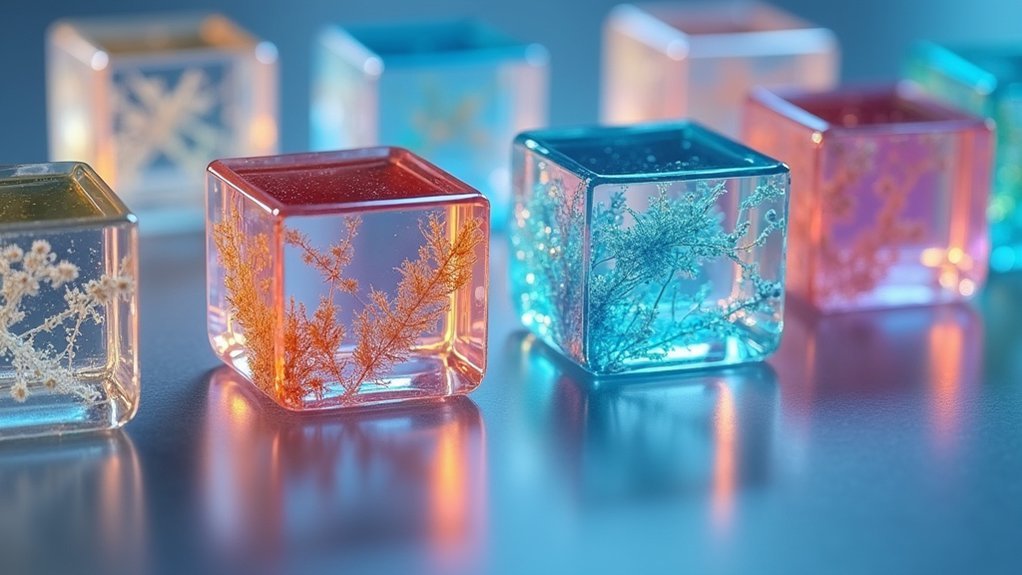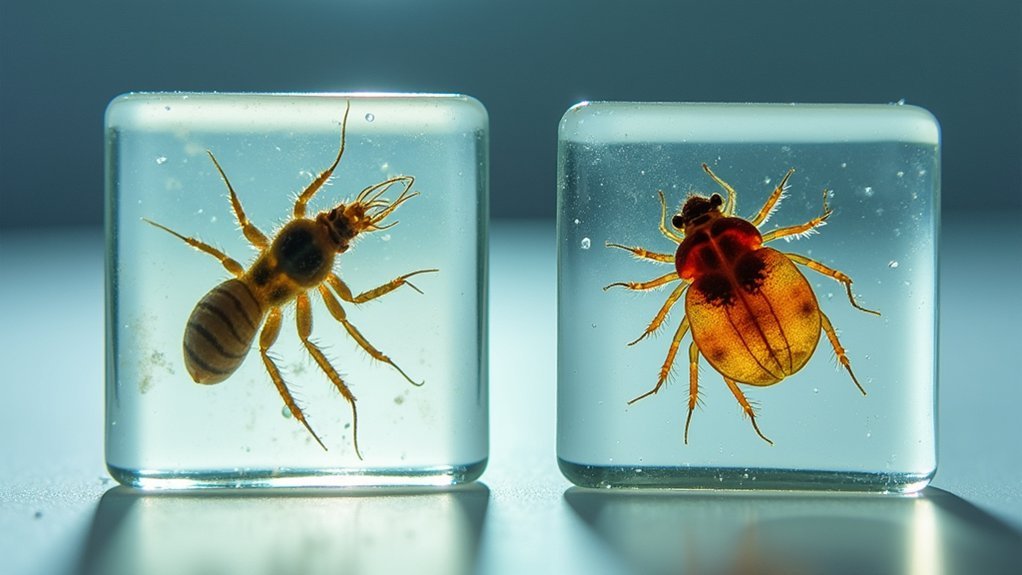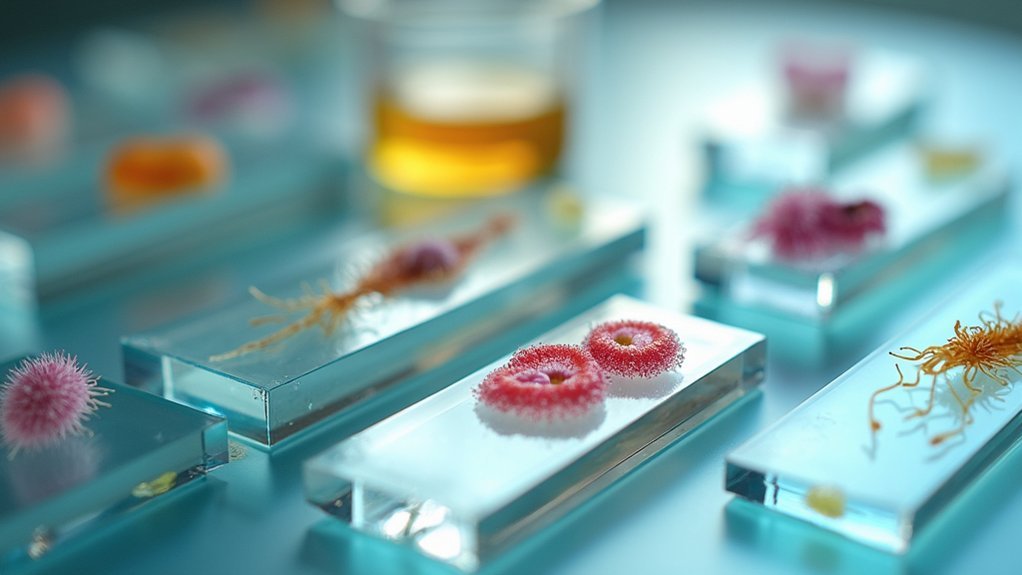For clear specimen imaging, choose mounting media with matching refractive index to your slide glass (around 1.51). Top options include VECTASHIELD® for fluorescence protection, ProLong Glass Antifade for long-term stability, VectaMount Permanent for archival storage, Fluoromount-G for quick aqueous applications, and glycerol-based media (RI 1.47) for general use. Your choice should align with your microscopy technique and preservation needs. The right mounting medium dramatically transforms your imaging results.
Understanding Refractive Index in Mounting Media Selection

When selecting mounting media for microscopy, the refractive index (RI) plays a critical role in producing clear, detailed images.
You’ll need to match your mounting media with both your specimen and glass components to minimize light scattering and distortion.
Water has an RI of 1.33, while glass slides and coverslips measure around 1.51. This mismatch can compromise image clarity unless properly addressed.
Water-based mounting media containing glycerol (RI 1.47) or solvent-based options (RI 1.45-1.49) help bridge this gap, optimizing visualization and preserving specimen details.
Antifade Properties for Preserving Fluorescent Specimens
Because fluorescent dyes gradually lose their luminosity when exposed to light, choosing mounting media with effective antifade properties is vital for high-quality microscopy. An antifade medium acts like sunscreen for your fluorescent detection molecules, protecting them from photobleaching through both oxygen-dependent and independent mechanisms.
Products like VECTASHIELD® and ProLong Glass Antifade contain antioxidants that mitigate photoinduced damage, greatly enhancing signal intensity during imaging sessions. You’ll notice improved fluorescence sensitivity, especially essential when working with low-abundance targets where every photon matters.
Don’t overlook the importance of antifade solutions for maintaining signal integrity in your mounted slides. Your choice affects not just immediate imaging results but also preserves specimens for long-term storage, ensuring your fluorescent dyes remain stable and vibrant for future examination.
Water-Based vs. Solvent-Based Mounting Media Comparison

Choosing between water-based and solvent-based mounting media represents a critical decision that affects both your workflow and final results.
Water-based media offer user-friendly application directly from aqueous buffers, while solvent-based options require dehydration steps but provide permanent preservation.
Consider your timeline: non-setting water-based media allow immediate viewing but need sealing, while setting media require up to 24 hours of drying time.
Both types optimize imaging conditions with refractive indices between 1.45-1.49, minimizing resolution loss in your specimen images.
Your storage needs also matter. Non-setting media work best for short-term applications and require refrigeration at 2-8°C.
For long-term preservation, solvent-based or setting water-based media offer better stability and can often be stored at room temperature, simplifying your specimen management.
High-Performance Mounting Media for Long-Term Storage
While temporary preservation serves some purposes, high-performance mounting media represent the gold standard for archival specimen storage. Products like VectaMount Permanent and ProLong Glass Antifade maintain specimen integrity for years without degradation.
Setting media offer superior long-term storage because they harden into solid films, preventing shrinkage and morphological distortion that can compromise your samples. Unlike non-setting media requiring refrigeration, these solutions provide stability at room temperature.
For fluorescently labeled specimens, antifade solutions like VECTASHIELD® are essential to prevent photobleaching, greatly extending the usable life of your preparations.
To maximize imaging quality, select mounting media with a refractive index matching glass (1.51). This optical compatibility ensures your specimens remain crystal clear, allowing for precise visualization even after extended storage periods.
Specialized Mounting Solutions for Different Microscopy Techniques

Different microscopy techniques demand specific mounting media to achieve ideal results.
Selecting appropriate mounting media is crucial – each microscopy technique requires specialized formulations for optimal visualization.
For immunohistochemistry, you’ll find VectaMount Express offers a non-toxic, time-saving solution that maintains stain integrity without additional chemicals.
When working with immunofluorescence, VECTASHIELD Antifade Mounting media protects your fluorescent molecules from photodegradation during imaging sessions.
Need quick sample viewing? Water-based aqueous mounting media like Fluoromount-G allow direct application from buffers.
For long-term storage, consider setting media such as ProLong Glass Antifade, which creates a solid film preventing shrinkage and air bubbles while enhancing specimen preservation.
Remember that matching the refractive index of your mounting media to glass components (approximately 1.51) is essential for optimizing image quality and minimizing resolution degradation in your microscopy applications, ensuring consistently clear images.
Frequently Asked Questions
What Is the Ideal Mounting Media?
You’ll want a mounting medium with a refractive index close to glass (1.51). Choose water-based setting media for preservation, antifade media like VECTASHIELD® for fluorescence, or non-setting media for immediate viewing.
What Are the Advantages of Canada Balsam Mounting Medium?
Canada balsam gives you excellent optical clarity with its glass-matching refractive index. You’ll appreciate its durability, enhancement of specimen details, compatibility with stains, and non-toxic nature that’s removable if you need adjustments.
What Is the Most Popular Mounting Media?
You’ll find VectaShield is widely considered the most popular mounting medium due to its exceptional signal preservation and photobleaching protection. ProLong Glass, Fluoromount-G, and DAPI Fluoromount-G are also highly favored by researchers.
What Is the Difference Between Hardening and Non Hardening Mounting Media?
Hardening media solidify into a firm film when dry, while non-hardening media stay liquid. You’ll need to evaluate drying time, specimen preservation duration, and potential shrinkage effects when choosing between these two options.
In Summary
You’ve now seen how proper mounting media directly impacts your image quality and specimen preservation. When choosing between water or solvent-based options, always consider the refractive index and antifade properties that match your specific application. Whether you’re capturing fluorescent samples or preparing slides for long-term storage, selecting the right mounting medium guarantees you’ll achieve clear, publication-worthy images with any microscopy technique.





Leave a Reply